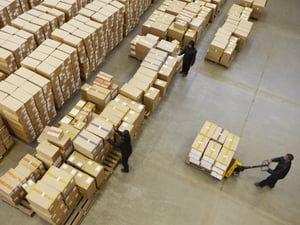 At first glance, packaging may not seem like a complex part of your business. After all, you’re producing high-quality industrial products. Your process probably involves complex engineering and design, an efficient production line, and a collective eye for detail and quality. Packaging is the easy part. You just put the product in the box and get it out the door, right?
At first glance, packaging may not seem like a complex part of your business. After all, you’re producing high-quality industrial products. Your process probably involves complex engineering and design, an efficient production line, and a collective eye for detail and quality. Packaging is the easy part. You just put the product in the box and get it out the door, right?
Not quite. In theory, industrial packaging should be simple. However, if it’s not done right, the packaging process could cause major problems for your business. Your quality could be in jeopardy, as could your ability to deliver on time. Also, if your packaging process hasn’t been designed with optimization in mind, you could be losing efficiency and money.
Below are three common challenges that industrial companies face when it comes to packaging. You’ll also find a few recommended solutions to those challenges. If you haven’t thought about your packaging process in a while, now may be the time to do so. You could be exposing your company to risk or even hurting your bottom line.
Challenge #1:
Ensuring product quality during shipment.
Priority number one of any packaging and distribution process should be ensuring the quality of the product. You’ve put considerable time, energy, money, and other resources into designing and producing your product. You may have to meet rigid quality standards for your customers, with minimal margin for error.
Considering how important quality is in the production process, shouldn’t you also make it a priority during packaging? Unfortunately, preservation of materials doesn’t always get the attention it should. Many industrial companies use an inexpensive crate or box system that may seem sturdy but actually exposes the product to risk.
For instance, a wooden crate is a common industrial packaging solution. It may seem strong, but what’s preventing the product from shifting inside the container? And what happens if rain, cold air, or other elements penetrate the box?
Unfortunately, we’ve seen it happen all too often. An industrial company uses an inexpensive or homegrown packaging solution to ship their product. When it arrives at the final destination, it’s damaged, and the company has to duplicate the order. That’s the kind of issue that can be a serious drag on your bottom line.
Solution: Leverage technology to manage quality risks.
How do you make sure your product’s quality is protected in transit? Work with a packaging partner who knows how to leverage technology and manage quality risks. You’re the expert in building your product. Delegate packaging to someone who is an expert in designing and building safe containers and insuring your products safe delivery.
Some industrial packaging companies even offer GPS and monitoring technologies, which can provide a live information feed as to the location and conditions that your package experiences. As the product progresses through the distribution path to its final destination, you and your packaging partner are able to monitor whether there have been any severe challenges, like impact, damage, humidity, or extreme temperature. You can then take action and prepare for delivery based on that information.
In addition, the most effective packaging partners have engineers on staff who use CAD software to design their industrial containers. They’re able to identify and quantify risk, and then make adjustments to the package design to minimize risk as much as possible.
Think about how much time and effort you put into your quality process. Make sure you dedicate the same level of care to the product’s packaging.
Challenge #2:
Delivering on time, every time.
Your customers are working on a tight schedule. They work with you because they know they can trust you to meet their deadlines. If you start to miss those deadlines, you’ll also start to lose their trust. That could force them to consider a different vendor.
You know this better than anyone. Consistently meeting customer deadlines is a vital part of your business. Even if you produce the product on your schedule, you’re still dependent on your packaging partner to get it crated and shipped on time. If they fail on their end, it could threaten the entire success of your process.
Solution: Use packaging and distribution technology to create a transparent shipping process.
Once again, the solution lies in technology. In this day and age, there shouldn’t be any mystery as to when your product will ship or where it is in the packaging process.
Unfortunately, many industrial packagers don’t offer a complete suite of technology products. They take your product and package it for you, and you hope that they do it fast enough to get it to your customer on time. You’re in the dark through the entire process.
The good news, though, is that many industrial packagers have invested in their technology offerings and can offer you transparency through the entire process. That allows you to see when your product hits each stage. When is it received by the packager? When is crated? When is it loaded onto the truck? Where is the truck?
In an ideal situation, both you and your customer would be able to quickly find the answers to these questions with just a few clicks of the mouse. You can see where the product is and when it will be at its final destination. If there’s a potential issue, you have the information you need to take action.
Your business depends on your ability to deliver on time. Have every tool possible at your disposal so you can meet those deadlines. If you don’t have visibility into your process, it might be time to consider alternative solutions.
Challenge #3:
Optimizing your process.
If your company is like most, improving efficiency is an ongoing effort. You’re probably always looking for ways to work smarter and faster. Have you examined your packaging process and how you could optimize it to reduce costs and boost efficiency?
If you have your own team members packaging your products, would it be more efficient for an outside company to handle it? If you’re sending your products off-site for a third party to package, would it be smarter for them to package in your facility? Could you save on distribution costs by shipping from a different location?
Solution: Work with a packager who has experience designing optimal packaging and distribution processes.
 You may not have the answers to those questions. In fact, you may not even know where to begin to find the answers. This is when it can be helpful to work with a packaging partner who not only builds crates, but also designs the entire packaging process.
You may not have the answers to those questions. In fact, you may not even know where to begin to find the answers. This is when it can be helpful to work with a packaging partner who not only builds crates, but also designs the entire packaging process.
They can examine your current process, identify inefficiencies, and the help you implement a solution that saves time and boosts your bottom line. Ideally, your packaging partner should have the resources to make the solution happen. Whether that means putting their people in your facility or even co-locating so they have a hub near your facility, the goal should be to implement the most efficient and optimized process possible.
Packaging is important, but it doesn’t have to be complicated. Having the right packaging partner can make your life easier and your process safer and more efficient. Do these three challenges sound familiar to you? If so, it might be time to take a fresh look at your industrial packaging process.





Let Us Know What You Thought about this Post.
Put your Comment Below.